17.4 Glaciations over Earth’s History
We are currently living in the middle of a glacial period, though it is less intense now than it was 20,000 years ago. This is not the only period of glaciation in Earth’s history; there have been many in the distant past (Figure 17.34). In general, however, over the course of Earth’s history the Earth’s surface has been warm and ice-free for longer periods than it has been cold and glaciated.

Pre-Cenozoic Glaciations
The oldest known glacial period is the Huronian. Based on evidence of glacial deposits from the area around Lake Huron in Ontario and elsewhere, it is evident that the Huronian Glaciation lasted from approximately 2.4 to 2.1 Ga. Because rocks of that age are rare, we do not know much about the intensity or global extent of this glaciation.
Late in the Proterozoic, for reasons that are not fully understood, the climate cooled dramatically, and Earth had the most intense time of glaciation it has ever experienced. The glaciations of the Cryogenian Period (cryo is Latin for icy cold) are also known as the “Snowball Earth” glaciations. Scientists have hypothesized that the entire planet was frozen at this time — even in equatorial regions — with ice on the oceans up to 1 km thick. A visitor to our planet at that time would not have found it habitable, although life still survived in the oceans.
There were two main glacial periods within the Cryogenian, each lasting for about 20 million years: the Sturtian at around 700 Ma and the Marinoan at 650 Ma. There is also evidence of some shorter glaciations both before and after these longer periods of glaciation. The end of the Cryogenian glaciations coincides with the evolution of relatively large and complex life forms on Earth. This started during the Ediacaran Period, and then continued with the so-called explosion of life forms in the Cambrian. Some geologists think that the changing environmental conditions of the Cryogenian are what triggered the evolution of large and complex life.
There have been three major glaciations during the Phanerozoic (the past 540 Ma). These include the Andean/Saharan (recorded in rocks of South America and Africa), the Karoo (named for rocks in southern Africa), and the Cenozoic glaciations. The Karoo was the longest of the Phanerozoic glaciations, persisting for much of the time that the supercontinent Gondwana was situated over the South Pole (~360 to 260 Ma). Glaciers covered large parts of Africa, South America, Australia, and Antarctica. This widespread glaciation, across continents that are now far apart, was an important component of Alfred Wegener’s evidence for continental drift. Unlike the Cryogenian glaciations, the Andean/Saharan, Karoo, and Cenozoic glaciations only affected parts of Earth. During Karoo times, for example, what is now North America was near the equator and remained unglaciated.
Earth was warm and essentially unglaciated throughout the Mesozoic. Although there may have been some alpine glaciers at this time, there is no evidence for them preserved in the geologic record. The dinosaurs, which dominated terrestrial habitats during the Mesozoic, did not have to endure icy conditions.
Cenozoic Glaciations
A warm climate persisted into much of the Cenozoic; there is evidence that the Paleocene (from about 50 to 60 Ma) was the warmest part of the Phanerozoic since the Cambrian (Figure 17.35).
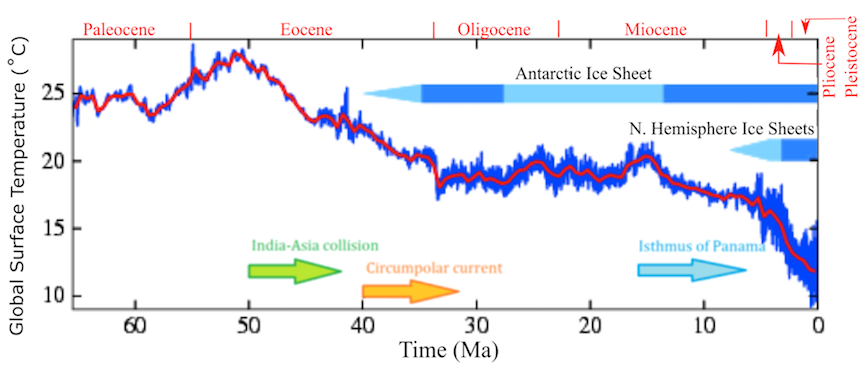
A number of tectonic events during the Cenozoic have contributed to persistent and significant planetary cooling from 50 Ma to near the present. For example, the collision of the Indian plate with the Eurasian plate and the formation of the Himalayan range and the Tibetan Plateau. Mountain building events such as the formation of the Himalayas are followed by weathering and erosion of the uplifted rocks. Higher than normal global rates of silicate mineral weathering associated with mountain building, especially weathering of feldspar, leads to a decrease in carbon dioxide concentrations in the atmosphere. This contributes to global climate cooling.
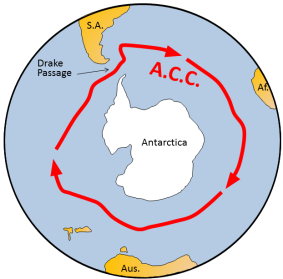
At 40 Ma, ongoing plate motion widened the narrow gap between South America and Antarctica, resulting in the opening of the Drake Passage. This allowed for unrestricted west-to-east flow of water around Antarctica: the Antarctic Circumpolar Current (Figure 17.36), which effectively isolated the Southern Ocean from the warmer waters of the Pacific, Atlantic, and Indian Oceans. The region cooled significantly, and by 35 Ma (Oligocene) glaciers had started to form on Antarctica.
Global temperatures remained relatively steady during the Oligocene and early Miocene, and the Antarctic glaciation waned during that time. At around 15 Ma, subduction-related volcanism between central and South America created the land connection between North and South America, preventing water from flowing between the Pacific and Atlantic Oceans. This further restricted ocean currents that transfer heat from the tropics to the poles, leading to cooling and advance of the Antarctic glaciation.
The expansion of the Antarctic ice sheet increased reflection of solar radiation at the Earth’s surface and promoted a positive feedback loop of further cooling. With more reflective glacial ice, there was more cooling, leading to accumulation of more ice, and so on. By the Pliocene (~5 Ma) ice sheets had started to grow in North America and northern Europe. The most intense part of the current glaciation — and the coldest climate conditions of the current glaciation — has been during the past million years (the last third of the Pleistocene).
The Pleistocene Epoch of the Cenezoic Era (2.58 Ma to 0.126 Ma), is also known as the Ice Age, Pleistocene Glaciation, or Quaternary Glaciation. The Pleistocene has been characterized by temperature fluctuations over a range of almost 10°C on time scales of 40,000 to 100,000 years. These temperature variations have corresponding with expansion and contraction of ice sheets. The temperature variations are attributed to subtle changes in Earth’s orbit, tilt, and wobble. These cyclical changes are called Milankovitch cycles. Over the past million years, the glaciation cycles have cycled over every 100,000 years, approximately (Figure 17.37).
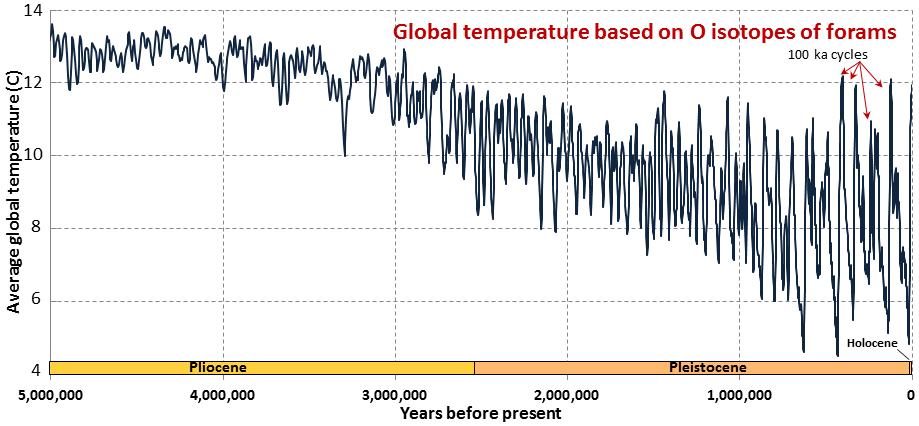
The Wisconsinian Glaciation
The Wisconsinan Glaciation was the last major continental glaciation in North America (from 150-50 ka). During the Wisconsinan, all of Canada and a small portion of the northern United States was covered with continental glaciers (Figure 17.38). The massive Laurentide Ice Sheet covered most of eastern Canada, as far west as the Rockies, and the smaller Cordilleran Ice Sheet covered most of the western region of present day BC and the Yukon Territory. At various other glacial peaks during the Pleistocene and Pliocene, the ice extent was similarly distributed over North America, and in some cases, was even more extensive. The combined Laurentide and Cordilleran Ice Sheets were comparable in volume to the current Antarctic Ice Sheet.
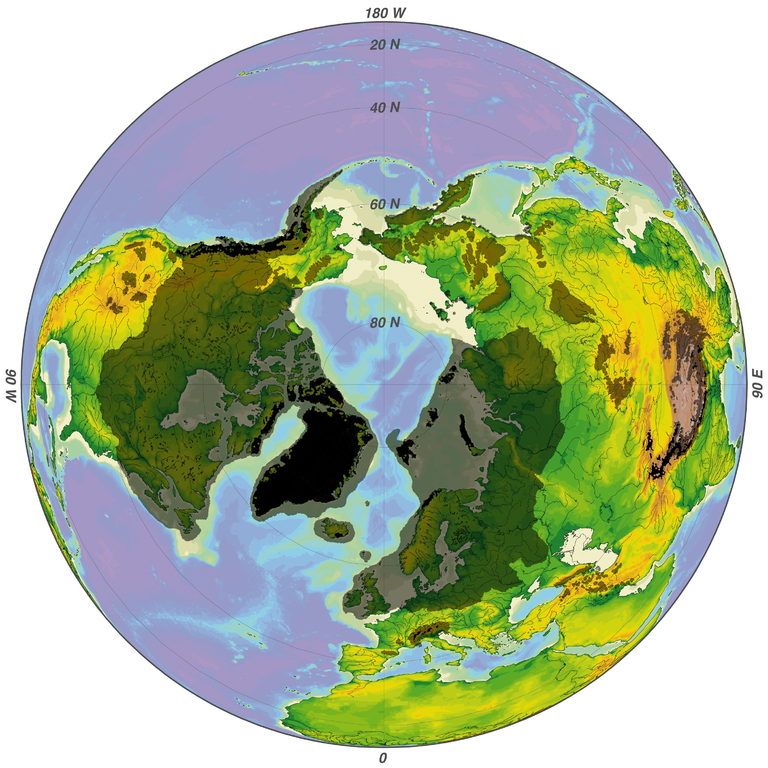
Exercise: Pleistocene Glacial and Interglacial Periods
Figure 17.39 shows the past 500,000 years of the data set used in Figure 17.37. The last five glacial periods are marked with snowflakes. The most recent glaciation, which peaked at around 20 ka, is known as the Wisconsinan Glaciation. Describe the nature of temperature change that followed each of these glacial periods.
The current interglacial period (Holocene) is marked with an H. Point out the previous five interglacial periods.
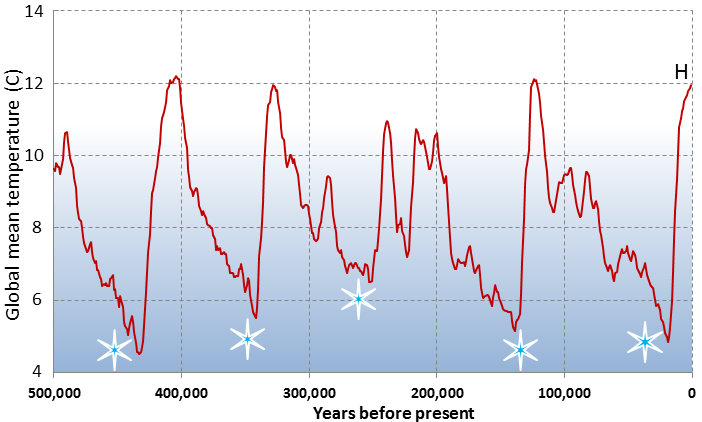
References
Hansen, J. E., and Sato, M. (2012). Climate Sensitivity Estimated From Earth’s Climate History. Read the paper
Lisiecki, L. E., and M. E. Raymo (2005). A Pliocene-Pleistocene stack of 57 globally distributed benthic d18O records. Paleoceanography, 20, PA1003. doi:10.1029/2004PA001071. View PDF
Zachos, J. C., Dickens, G. R., and Zeebe, R. E. (2008). An early Cenozoic perspective on greenhouse warming and carbon-cycle dynamics. Nature 541, 279-283. doi:10.1038/nature06588

